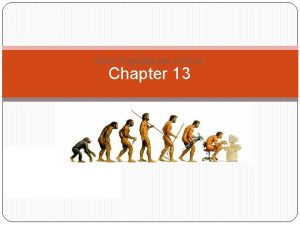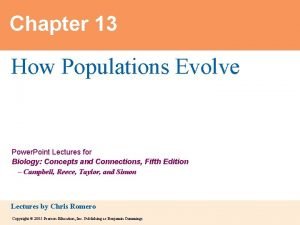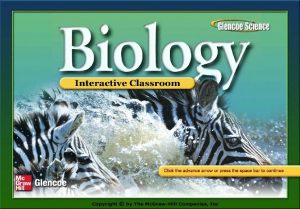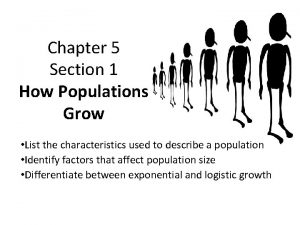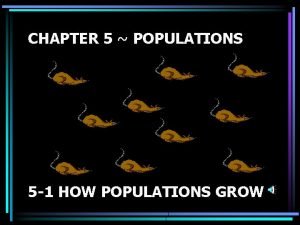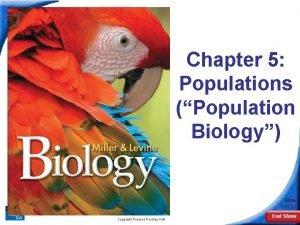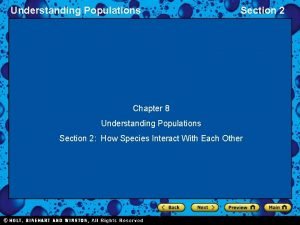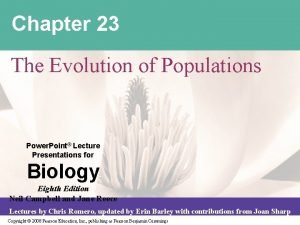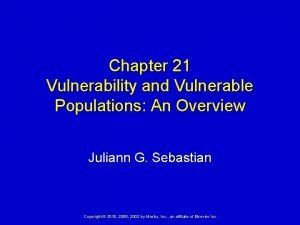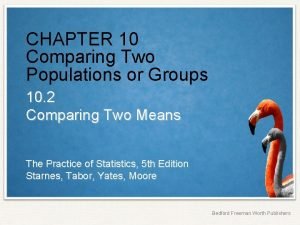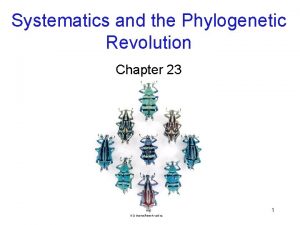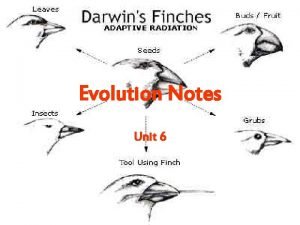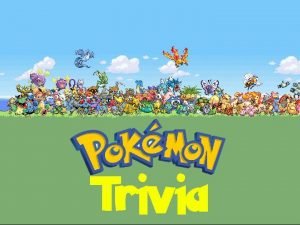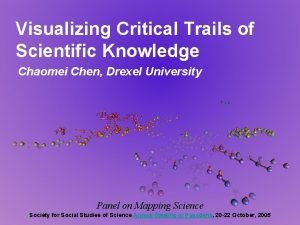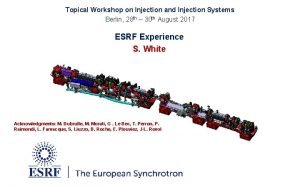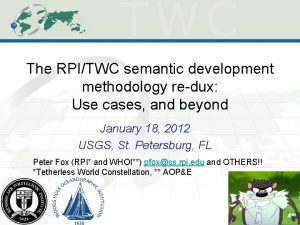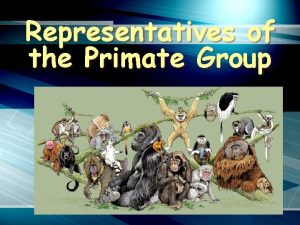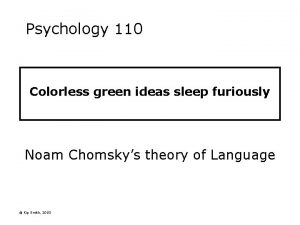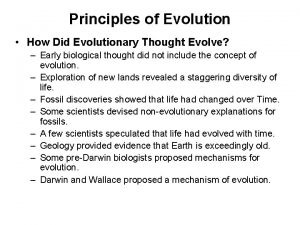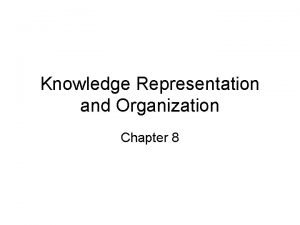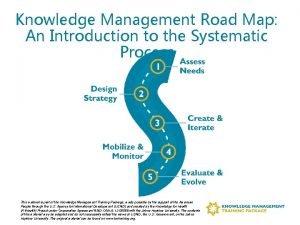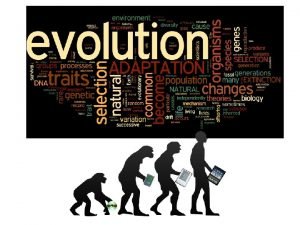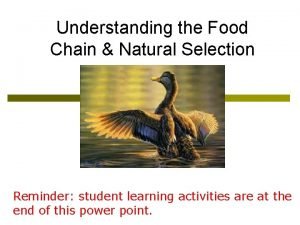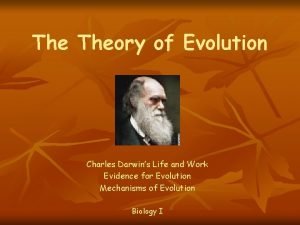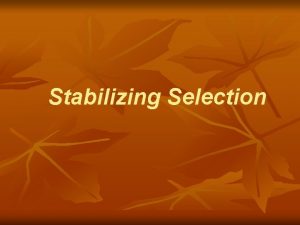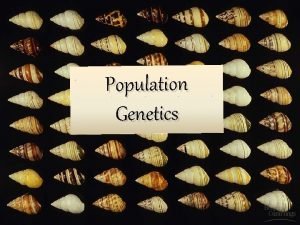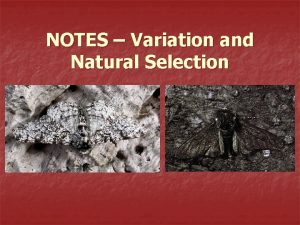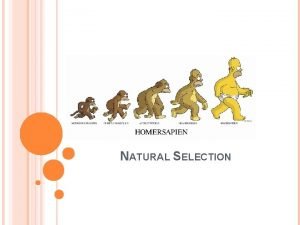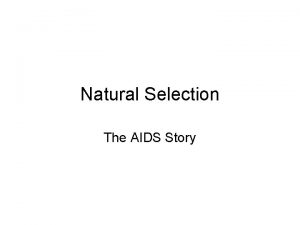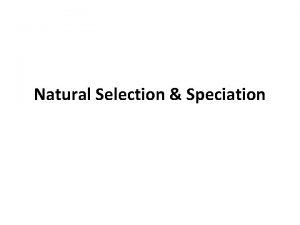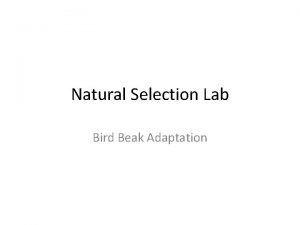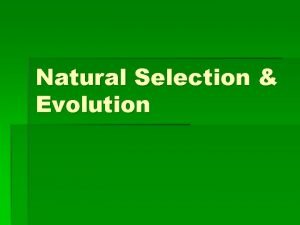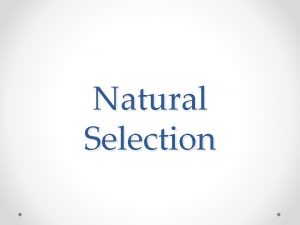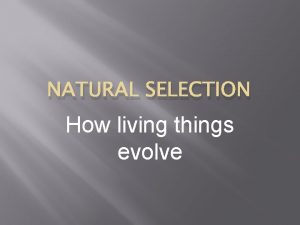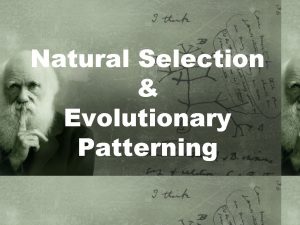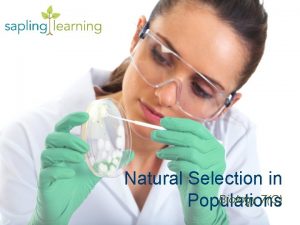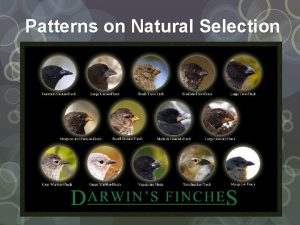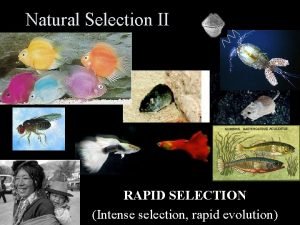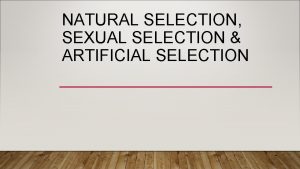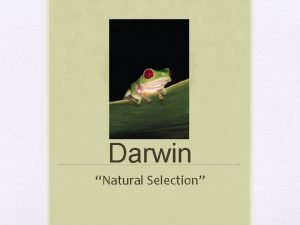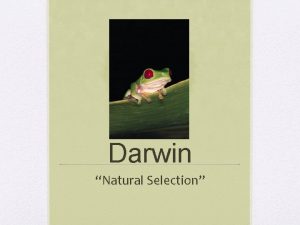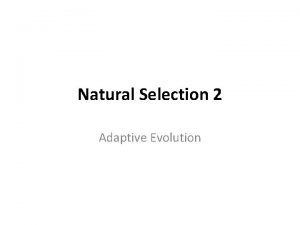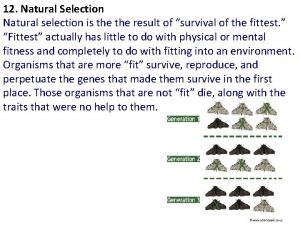How Populations Evolve Chapter 7 Natural Selection On

























































- Slides: 57

How Populations Evolve Chapter 7

Natural Selection? • On the following three slides, you will read statements based on student ideas about now natural selection works. Use your clickers to vote for whether you think that the statement IS or is NOT what scientists mean by “natural selection. ”

“ Our little toes aren’t necessary for walking. Because of this, some people think that they will get smaller each generation and eventually disappear from lack of use over time. ” 1. This IS what scientists mean by natural selection 2. This is NOT what scientists mean by natural selection

“Dark-colored grasshoppers resting on pale, dry grass stalks are more easily seen by predators than light-colored grasshoppers of the same species. Because the dark-colored grasshoppers have higher mortality, there will be fewer darkcolored grasshoppers each generation” 1. This IS what scientists mean by natural selection 2. This is NOT what scientists mean by natural selection

“The flowering shrub called Hydrangea has flowers that are blue if the shrub is growing in acidic soil. If the same shrub is transplanted into alkaline soil, its blossoms will turn pink. ” 1. This IS what scientists mean by natural selection 2. This is NOT what scientists mean by natural selection

How Selection Works

1. Variation Exists • All populations vary as the result of the accumulation of small, random mutations over many generations.

2. Inheritance of traits • Inheritable traits (those coded for by genes) are passed directly to the offspring from the parents through genetic information.

3. Differential Survival • More offspring are born than can survive. Many offspring die young. Those with traits best suited to the environment are more likely, though not guaranteed, to survive.

4. Differential Reproduction • Some survivors fail to reproduce. Some have traits that better insure reproduction than others.

5. Differential Inheritance • Survivors that reproduce pass some of their traits on to their offspring. Those with favorable traits may pass those favorable traits on — or not.

W O R K • People who work with feral cats have noticed that when cats are abandoned to the wild and have kittens, over several T generations the kittens are more and more feral and more difficult to tame. Use O G what you have learned about natural E selection to develop a brief explanation T for this. Talk to your neighbor about your H ideas. E R

Natural Selection in Cats • Traits that ensure a domestic cat’s survival among humans: • Endearing qualities: purring, snuggling, being playful, cuteness. • Helpful qualities: rodent control.

• When domestic cats are abandoned: • Most die within two weeks from starvation, accident, or predation. The traits that help them in a domestic setting are useless in the wild. • The few that survive have the strongest feral instincts. • Av. feral lifespan: 2 -4 years

Selection’s Effects Generation 1 Generation 2 Generation 3

As time passes. . . • With each generation, domestic traits are selected against, while feral traits are favored. • After several generations, even kittens that are captured young can be challenging to tame.

Which of these is true? 1. Nature gives abandoned cats the traits that they need to live in the wild. 2. Only those few cats with traits that help them avoid predators and catch prey will survive and have offspring.

Genes and Evolution • Genes are the units of heredity. • Genes are segments of DNA that code for proteins, which result in our set of traits. • Genes are passed from parent to offspring through the sex cells.

• Different “versions” of genes are alleles. • Dominant alleles are expressed in the phenotype (expressed trait) even if only one copy is inherited. • Recessive alleles are expressed only if two copies are inherited. “Genotype” is a description of the alleles for a given trait in an individual: BB, Bb, or bb

Genetic basis of inheritance • Genotype - the genetic composition of an organism Allele - the specific form of the gene • Phenotype - the outward expression of genotype • Gene pool - the total of alleles for all genes in a population BEY 2 gene – controls pigmentation in the eye

You’re probably familiar with genetics in terms of following traits passed from parent to offspring and predicting the outcome. Blackfin shark genotypes in the Gulf of Mexico. http: //www. zoology. siu. edu/heist/blacktip. htm But how do we track traits passed from generation to generation across an entire population? How does population genetics work?

The Gene Pool Concept • The “gene pool” of a population is the entire collection of alleles for a given trait throughout a given population. • The word for all genes for all traits in an individual or population is genome.


Genetic change Mutation, genetic drift, and natural selection will, over time, change the genetics of both populations. Genetic change Causes of Genetic Change in a Population

Hardy-Weinberg Equilibrium • Allele ratios in a gene pool will NOT change from generation to generation (that is, no evolution) ONLY if ALL of these things are true: • No mutation • Large population • No migration • No selection • Random mating

Mutations • Small mutations appear randomly in populations. • The appearance of mutations changes allele ratios by • “breaking” functional alleles (as in genetic disorders) • adding new alleles

• Copy errors are rare, but given that genes are copied millions of times in a lifetime, errors can occur. • Mutagens in the environment can increase the error rate. • Small errors can create new alleles.

Population size • In large populations, random events have a very small effect. • In small populations, because fewer individuals have any given trait, random events can have a larger effect. Changes in gene ratios caused by random events are called “genetic drift. ”


A population bottleneck is genetic drift.

Founder effect is genetic drift.

What does Founders Effect do to the gene pool of the new population? 1. Improves it by weeding out bad genes. 2. Creates new traits that the new population will need. 3. Makes it much smaller with less genetic variation.

Why is a genetic bottleneck of concern to wildlife biologists bringing an endangered species back from near extinction? 1. Small populations have more mutations. 2. The small gene pool increases inbreeding and preservation of bad traits. 3. Much harder to find survivors for breeding programs.

Migration • Migration into and out of a population can change gene ratios. • Immigrants can bring in new mutations, or a different ratio of alleles. • Emigrants may take away a high proportion of a certain allele. • Small population are more affected than large populations.

Migration can lead to Founders Effect: Surtsey, Iceland Surfaced 14 Nov 1963 Moss: 1967 Puffin nests: 2004

Selection • Selection may increase or decrease the frequency of certain alleles: • Directional selection: favors one end of a range over another. • Disruptive selection: disfavors the midrange. • Stabilizing selection: favors the mid-range.


Natural selection: Differential survival. Peppered moth Changes allele frequency.

Which of these is true? 1. Predation caused the Peppered Moths to develop new genes that they needed to survive. 2. Predation changed the gene frequencies already existing in the population.

The phenotype on which selection acted in the Moth example was: 1. 2. 3. 4. 5. Predation Level of pollution Size of trees Number of trees Coloration pattern of moths

The abiotic variable that influenced natural selection in moths was: 1. 2. 3. 4. 5. Predation Pollution level Size of trees Number of trees Coloration pattern on moths.

The biotic variable that influenced selection in moths was: 1. 2. 3. 4. 5. Predation Level of pollution Size of trees Number of trees Coloration pattern on moths.

Mating Behavior • Mate choice among most organisms is selective, not random. • Sexual selection may favor traits that are in conflict with natural selection. For example, bright-colored male guppies attract more females, but are also more visible to predators.


Sexual selection: competition to mate Widow bird (text E 1 -2 pg 13)

We can measure phenotype Number of males with different tail lengths in a population of redcollared widowbirds. Data based on Pryke and Andersson 2002.

Selection acts directly on… 1. 2. 3. 4. Genotype Phenotype Environment Depends on if it is natural or sexual selection.

Antibiotic Resistance • Antibiotic resistance has been an increasing problem since the 1970 s. • How does natural selection contribute to the rise in antibiotic-resistant bacteria? (Note it is bacteria that become resistant, not people. Bacteria do not become “immune” — they do not have immune systems. )

Which of these is true? 1. Antibiotics cause bacteria to develop immunity. 2. Antibiotics kill the leastresistant bacteria. 3. Antibiotics cause people to resist their effects. 4. Antibiotics create new mutations in bacteria that cause resistance.

• Use the principles of natural selection to explain antibiotic resistance. Be sure to include these in your answers: • Variation in the original population. • Differential survival. • Differential reproduction • “Need, ” “purpose, ” and “immune” should not be in your answer! W O R K T O G E T H E R


Helicobacter pylori is a bacteria that causes stomach ulcers. Most H. pylori bacteria, when encountering an antibiotic, metabolize it with an enzyme that turns it to a toxin. A few H. pylori bacteria have a mutation that interferes with the production of the enzyme. The mutant bacteria aren’t affected by antibiotics.

• Which of these explanations correctly uses the Theory of Natural Selection to explain antibiotic resistance in H. pylori? • The antibiotic caused the mutation that made the bacteria resistant. • The bacteria needed to resist the antibiotic, so they adapted by changing their enzyme. • Those bacteria already in the population with the mutation were able to survive the antibiotic, so those were the bacteria that reproduced. W O R K T O G E T H E R

Using antibacterial hand soap many times each day is: 1. A good idea because it kills all bacteria. 2. A good idea because it kills both bacteria and viruses. 3. A bad idea because it causes mutations in bacteria. 4. A bad idea because it serves as a selective factor for resistant bacteria.

Evolution Happens • Because perfect Hardy-Weinberg equilibrium is never met with in nature, all populations experience small shifts in gene ratios with each generation. • Gene ratio shifts may fluctuate with cyclical changes in climate. Long-term changes in habitat (such as global climate change) can shift the gene ratios far enough to bring about speciation.

• Choose ONE of these and explain how a knowledge of mechanisms of evolution could be useful to: • A public health official dealing with an outbreak of pneumonia in a homeless population. • A zoo that wants to start an endangered species breeding program. • A Fish and Wildlife zoologist who is concerned about the decline in size and health of bull elk over the last 50 years. W O R K T O G E T H E R

Recap • Natural Selection is a phenomenon that can be studied directly. • Natural Selection causes change in the genetics of a population over generations (evolution). • Other factors that can change genetics of a population include migration, sexual selection, mutations, and effects of random events in small populations.
 Chapter 13 how populations evolve test
Chapter 13 how populations evolve test Chapter 13 how populations evolve
Chapter 13 how populations evolve Individuals don't evolve populations do
Individuals don't evolve populations do Similarities
Similarities Natural selection vs artificial selection
Natural selection vs artificial selection Difference between continuous and discontinuous variation
Difference between continuous and discontinuous variation Disruptive selextion
Disruptive selextion Natural selection vs artificial selection
Natural selection vs artificial selection Chapter 15 section 1 darwins theory of natural selection
Chapter 15 section 1 darwins theory of natural selection Chapter 16 evolution of populations vocabulary review
Chapter 16 evolution of populations vocabulary review Chapter 17 evolution of populations answer key
Chapter 17 evolution of populations answer key 5-1 how populations grow
5-1 how populations grow 5-1 how populations grow
5-1 how populations grow Chapter 23 the evolution of populations
Chapter 23 the evolution of populations Chapter 16 evolution of populations
Chapter 16 evolution of populations Chapter 10 comparing two populations or groups crossword
Chapter 10 comparing two populations or groups crossword 5-1 how populations grow
5-1 how populations grow Chapter 8 understanding populations
Chapter 8 understanding populations Chapter 23 the evolution of populations
Chapter 23 the evolution of populations Chapter 21 vulnerability and vulnerable populations
Chapter 21 vulnerability and vulnerable populations Chapter 10 comparing two populations or groups
Chapter 10 comparing two populations or groups Balancing selection vs stabilizing selection
Balancing selection vs stabilizing selection K selection r selection
K selection r selection Logistic model of population growth
Logistic model of population growth Two way selection and multiway selection in c
Two way selection and multiway selection in c Multiway selection in c
Multiway selection in c Mass selection
Mass selection Explore evolve validate prototype
Explore evolve validate prototype City & guilds evolve
City & guilds evolve Secureassess evolve
Secureassess evolve Explore evolve validate prototype
Explore evolve validate prototype Richard millwood
Richard millwood Most complex characters evolve
Most complex characters evolve Evolve
Evolve Pokemon
Pokemon Evolve knowledge
Evolve knowledge Evolve berlinist
Evolve berlinist Evolve knowledge
Evolve knowledge Prosimii
Prosimii Colorless green ideas sleep furiously
Colorless green ideas sleep furiously History of evolutionary thought
History of evolutionary thought Evolve knowledge
Evolve knowledge Evolve knowledge
Evolve knowledge Evolve knowledge
Evolve knowledge Evolve
Evolve Analogous structures
Analogous structures Eveek
Eveek P**n
P**n 4 principles of natural selection
4 principles of natural selection Stabilizing natural selection definition
Stabilizing natural selection definition Requirements for natural selection
Requirements for natural selection Natural selection 3
Natural selection 3 Theory of natural selection
Theory of natural selection 4 conditions of natural selection
4 conditions of natural selection 3 types of natural selection
3 types of natural selection Bird beak adaptation lab
Bird beak adaptation lab 3 types of natural selection
3 types of natural selection Natural selection biology definition
Natural selection biology definition
